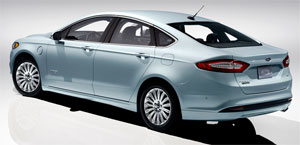2013 Ford Fusion Energi
The second generation Ford Fusion mid-size sedan, launched for 2013, has been a huge success for Ford. While its style has won it many awards, its substance has won it even more buyers. Plus the Fusion Hybrid already offers best in class fuel economy. But, Ford is out to take the gasoline-electric mantra away from Toyota. And their hope is that all it takes is a little…Energi.
The 2013 Ford Fusion has indeed made headlines for Ford, and while they haven’t all been positive, our overall take on the Fusion couldn’t be more optimistic, and the Fusion Energi is part of the reasoning. That positive energy comes from the Energi adding a fuel efficient plug-in system, setting it above the already best in class Fusion hybrid.
Driving down the road, the plug-in hybrid Energi operates the same as the standard Fusion hybrid, the exception being that with a larger 7.6-kWh battery, the electric-only driving range expands from about a mile, to 15-20 miles.
Once the battery is suitably drained, you’ll switch over to normal hybrid gas-electric operation. And unless you’re driving on a smooth road without the radio or climate system on, you’ll have a hard time telling exactly when the gas engine is running and when it’s not; it’s almost totally transparent, which is the way we like our technology here at MotorWeek.
 While the 2.0-liter I4 based powertrain is the same as the hybrid, outputting 141-horsepower and 129 lb-ft. of torque, here it seems quieter and overall more impressive than our earlier tests, and the whole driving experience feels substantial and well done.
While the 2.0-liter I4 based powertrain is the same as the hybrid, outputting 141-horsepower and 129 lb-ft. of torque, here it seems quieter and overall more impressive than our earlier tests, and the whole driving experience feels substantial and well done.
The Energi essentials come from the C-Max Energi, and much like the C-Max it’s easy to get used to driving on EV power alone, and it quickly becomes a game to see how many EV miles you can manage before the four-cylinder kicks in. It’s a game where everyone is a winner, except maybe the local gas station.
The Fusion Energi’s biggest competitor is naturally the Toyota Prius Plug-in Hybrid, and it beats it in just about every category, whether you’re talking EV range, overall range, and MPGe rating. The Prius still holds the edge when it comes to overall MPG rating, but the Fusion’s Government Fuel Economy Ratings of 44–City, 41-Highway, and 43–Combined are still extremely impressive, especially given its size. We averaged 46.4 miles per gallon, and as with all plug-ins, the more EV time, the better your results.
The Energy Impact Scores are also excellent; yearly oil consumption of just 4.2-barrels, and CO2 emissions of 1.8-tons.
The overall quality and fit-and-finish of the interior continues to get high marks from our testers, but most still find it hard to get comfortable in Fusion driver’s seat. We’re still not enamored with MyFordTouch either. There’s little tactile feel, so you need your eyes to see the command screen which can be more distracting than useful. Hopefully Ford’s plan to bring back real knobs and buttons will help future versions.
The only real compromise for the plug-in Energi is in trunk space. The larger batteries take up more room, dropping cargo capacity to just 8.2 cubic-ft. That makes the Energi more of a commuter car than a family road tripper.
 We’ve always had high praise for the Fusion’s exterior design, and it definitely continues to look upscale. To us, it’s still the best looking family sedan currently on the market. Behind the wheel it also feels like more of a luxury sedan than even the larger Taurus. But, it can’t run with the bull down our test track, with a mediocre 0-60 of 8.5-seconds. Handling is typically Fusion, which means it’s a step above the average family sedan, but not quite in sport sedan territory.
We’ve always had high praise for the Fusion’s exterior design, and it definitely continues to look upscale. To us, it’s still the best looking family sedan currently on the market. Behind the wheel it also feels like more of a luxury sedan than even the larger Taurus. But, it can’t run with the bull down our test track, with a mediocre 0-60 of 8.5-seconds. Handling is typically Fusion, which means it’s a step above the average family sedan, but not quite in sport sedan territory.
For the privilege of plugging in your Fusion Energi, you will pay a premium of about $8,000, with SE trim starting at $39,495 and Titanium trim coming in at $40,895. That is steep, but you do get a lot for the money as the Fusion Energi is one well working high tech automobile.
We love what Ford has accomplished with the 2013 Fusion Energi. If the ultimate goal is outstanding fuel economy for a true five passenger, mid-to-large sedan, with no compromises, Ford is very close. But having to stuff so much extra hardware into an existing chassis does have its price.
On the other hand, with Ford putting this much “energy” into their mainstream family sedan, we are very optimistic that soon they will go all the way.
Specifications
- Engine: 2.0-liter I4
- Horsepower: 141
- Torque: 129 lb-ft.
- 0-60 mph: 8.5 seconds
- EPA: 44 mpg city/ 41 mpg highway
- Energy Impact: 4.2 barrels of oil/yr
- CO2 Emissions: 1.8 tons/yr






